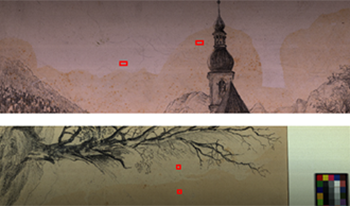
Drawing materials, such as soft graphite or charcoal applied on paper, may be prone to smearing during transport and handling. To mitigate this effect, it was common practice among 19th century artists to apply a fixative on drawings made in friable media. In many cases, the fixative has been imperative in preserving the drawings, although it may also have altered the appearance of the paper and/or the media. It is rarely possible to identify the type of fixative used, without using analytical techniques that require sample taking. As the fixative layer is very thin, any sample will often also contain small fragments of the paper. In this article, we are proposing a non-invasive approach for recognizing fixatives based on their spectral signatures in the visible and near-infrared range, collected with a hyperspectral imaging device. Our approach is tested on mock-up samples designed to contain fixatives of animal and vegetal origin, and on two drawings by the Norwegian artist, Thomas Fearnley.